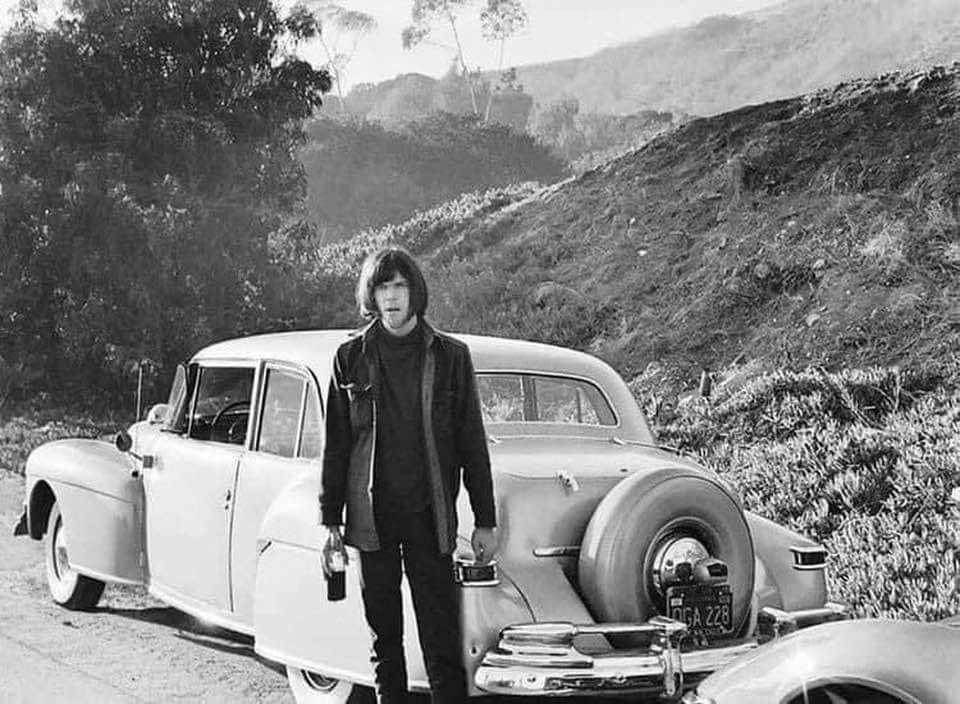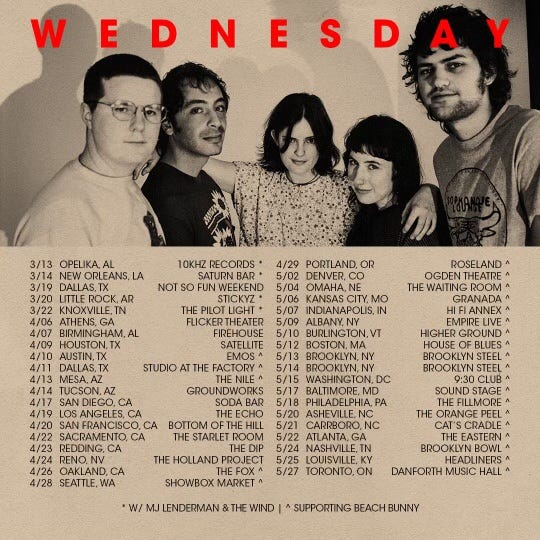MJ Lenderman in the key of Neil Young
The Asheville alt-country rocker isn’t just mimicking a sound...
They say history repeats itself.
Bell bottoms. Indie sleaze. A Trump presidency. Across fashion, politics, music, and entertainment, the past doesn’t just return. It insists on being seen.
In 2024, alternative country-rock artist Jake “MJ” Lenderman emerged as one of indie’s most polarizing figures. His fourth studio album, Manning Fireworks, earned a high spot on Rolling Stone’s year-end list, while critics (like the notorious internet personality and music reviewer Anthony Fantano) dismissed Lenderman as recycled nostalgia.
Any time Lenderman’s name pops up—by these critics, especially—Neil Young’s isn’t far behind. This comparison is made incessantly, with some flat out rejecting it, and others embracing it wholeheartedly. In her profile of Lenderman for The New Yorker, Amanda Petrusich compares Lenderman’s “warm and astringent rock and roll” to the bygone-era of Young’s 1968 self-titled debut. The Atlantic’s Spencer Kornhaber refused this comparison, arguing that Lenderman’s rendition of Americana rock goes against what indie rock stands for at its core—innovation and evolution.
And Lenderman himself has acknowledged Young’s impact, even if indirect, on his sound, telling Billboard, “I can trace back most bands that I like to Neil.” He’s discussed having read Shakey, Young’s biography, just before recording Manning Fireworks. Harvest Moon even inspired him to buy a harmonica.
But there’s a deeper connection between the two musicians that goes far beyond their music sounding similar. While the comparisons often focus on surface-level sonic similarities—voice, guitar, twang—they miss the deeper ways Lenderman channels Young: not just in sound, but in the way he builds a career on his own terms.
Lenderman’s artistic ethos, the way he’s carried himself through his career over the past eight years, feels modeled on the Young playbook: genre-fluid, community-driven, and above all, fiercely independent. He weaves through different groups and collaborations within his musical ecosystem, while still propelling his solo career forward. Looking at Lenderman’s rise against Young’s, it becomes clear that Lenderman—while obviously inspired by Young musically—has built for himself a similar place in the greater music landscape that gave Young his decades-long career.
Young and Lenderman both got their starts in small towns, playing in makeshift bands with high school friends. For Young, it was the Squires; for Lenderman, Slugly. Young became a folk figurehead in Winnipeg, where he met musicians like Stephen Stills and Joni Mitchell, who would all eventually move to Laurel Canyon. Lenderman played shows at local Asheville venues like The Gray Eagle, building his chops in these small halls and making a name for himself, existing in a never ending circle of collaboration and experimentation. Asheville connected Lenderman with musicians like Connor Miller of the popular local band Brucemont, who became his entry point to the tight-knit scene.
Laurel Canyon was Young’s next step. The Canyon is where Young and Stills started the Buffalo Springfield, becoming one of the most prominent bands of late-’60s country folk. In a 1970 piece for Melody Maker, Jacoba Atlas described Laurel Canyon as a place that “offered a refuge from the chrome and plastic of Los Angeles.” The community of musicians who flocked to the canyons in the mid-‘60s (Young and Stills along with Mitchell, Frank Zappa, John Mayall, David Crosby and the rest of The Byrds) grew into a collective of artists on their way to becoming the harborers of the New Rock and Roll.
Lenderman’s Laurel Canyon was Haw Creek, a rambling country compound in Asheville that served a similar purpose as the canyons: a place for musicians to collaborate and create together—while hiding from the rising rent prices in the city. Lenderman moved into Haw Creek in the summer of 2018, and, as noted in his recent GQ profile, the compound became “a hub for wayward local musicians.” Lenderman and Miller—along with other artists like Ethan Baechtold and Xandy Chelmis—wrote, recorded, swappeds songs, and appeared on each other’s tracks, just like their canyon counterparts a half-century earlier. Miller, Chelmis, and Baechtold still play drums, fiddle, and piano, respectively for Lenderman’s backing band, The Wind. Chelmis and Baechtold are also members of Wednesday.
Young was an avid collaborator, writing songs for the likes of Linda Rondstat and Rita Coolidge, recording guitar on tracks for The Monkees and The Carpenters, and playing on demos with Joni Mitchell, all while writing and recording with the Springfield. In 1968, Young ventured out on his own after leaving the Springfield for the second and final time. He later joined forces with fellow canyon collaborators Graham Nash, Stephen Stills, and David Crosby—at first providing guitar and vocals for their live shows. Soon after, he wrote two songs (“Helpless” and “Country Girl”) for Déjà Vu (1970), which became the group’s first official album as a foursome: Crosby Still Nash and Young.
But for Young, his independence remained paramount. Michael Watts evaluated Young’s musical endeavors for Melody Maker in 1971, writing: “The musical balance in the ‘70s has swung towards the artist practicing autonomy, for while Young is frequently featured with Crosby et al (or has been in the past) it is as an individual featuring his art outside that particular group framework that he has achieved his major recognition and done his best work.”
Where Young found his voice and honed his sound with the Springfield, Lenderman found his creative identity in Wednesday, the country-punk group led by Lenderman's then-girlfriend Karly Hartzman. And their breakout 2023 album, Rat Saw God, helped get more eyes on Lenderman’s previous solo efforts. Lenderman has since announced that he will no longer tour with Wednesday, but he remains an avid collaborator, recently playing on the entirety of Waxahatchee’s Tigers Jaw—on top of singing on the album’s breakout single, “Right Back To It.” Lenderman has entered a new phase—one where he’s not just part of the scene, but shaping it. He does all of this while maintaining his independence, consistently releasing albums and performing shows under his own name
Lenderman’s backing band—The Wind—is eerily similar to Young’s work with Crazy Horse, who he still tours with to this day. Young felt it paramount to always have multiple things going on at once (CSNY, writing for his contemporaries), but his solo work remained his top priority. In 1971, he told Rolling Stone: “Crazy Horse is funkier, simpler, more down to the roots”—comparing it to his work with CSNY. “I didn’t want Crazy Horse to die just as we were getting it together.” Lenderman found a similar balance with Wednesday, the band becoming the space for him to lean into his thrashing punk tendencies, while his solo work and live presence went on a jammier country-rock path.
When Neil Young released Harvest in 1972, he was propelled into a different type of commercial stardom. “Heart of Gold” reached No. 1 on the Billboard Hot 100, and the LP became the best-selling album in the US in 1972. Manning Fireworks could very well be considered Lenderman’s Harvest—though on a lesser indie-rock scale. (The music industry, post-streaming, now exists very differently than it did in 1972.) While Lenderman hasn’t reached the same commercial success as Young, Manning Fireworks has thrust him more into the mainstream, making him a figurehead representing the latest rendition of alt-country rock. He knows it, too: “With every new phase of my ‘career,’ or whatever visibility I have,” Lenderman recently told GQ, “I have to make new adjustments to protect what I am doing.”
If Lenderman keeps on Young’s trajectory, we should expect his next album to be a complete rejection of everything musically that he’s done previously, as well as a full rejection of the fame that’s come along with it. Young followed up Harvest with Time Fades Away in 1973, a live album that was recorded on the strenuous, 90-day, 65 show tour to support the success of After the Gold Rush and Harvest and confused listeners and critics alike with its scrappy, rough-around-the-edges performances. In the album’s liner notes, Young wrote that he released this record, “so you folks could see what happens when you lose it for a while.” The Time Fades Away version of “Journey Through the Past” is especially heartbreaking; just Young and a piano, calling out to a lost love and wondering if she still thinks of him. He slurs across the rest of the record, warbling his way through “Yonder Stands the Sinner” and the bluesy “Don’t Be Denied.” In their review, Rolling Stone wrote that the album “shows Young’s reticence of being a public figure.”
Lenderman is now dealing with his own experiences with celebrity. He and Wednesday’s Karly Hartzman kept their breakup a secret for months before telling their band members—let alone the masses. Now, every profile surrounding Lenderman and Manning Fireworks includes some interlude about the relationship—and when coincidences like both musicians covering Counting Crows’ “A Long December” at their respective shows in the same week happen, social media lights up with the parasocial projections and break-up theories. At the time of writing, Lenderman does not run any of his own social media accounts. (And imagine if Young had Twitter in 1973.)
Lenderman may have followed a familiar arc, but the choices he makes now—what to embrace, what to reject, how to protect his craft—are his alone. Like Young, he’s committed to the long game. But the light he’s stepping into isn’t just cast by the past—it’s one he’s making for himself.













https://open.substack.com/pub/johnnogowski/p/theres-room-for-you-in-neil-youngs?r=7pf7u&utm_medium=ios